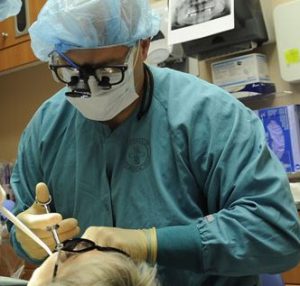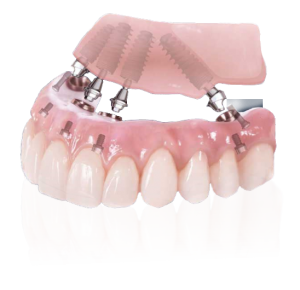Procedures
Sedation:
 Dental Surgery can cause anxiety or fear within us, Fortunately, modern anesthesia technology now makes it possible to perform even complex surgeries in the dental office with little or no discomfort to the patient where the primary goal is to provide the patient with the most comfortable, safe, and convenient care possible.
Dental Surgery can cause anxiety or fear within us, Fortunately, modern anesthesia technology now makes it possible to perform even complex surgeries in the dental office with little or no discomfort to the patient where the primary goal is to provide the patient with the most comfortable, safe, and convenient care possible.
In cases involving dental surgery, local anesthesia that numbs the surgical area (Novacaine) is used either by itself or in combination with one or more of the following: nitrous oxide (sometimes called “laughing gas”) to relax you; oral pre-medication; intramuscular or intravenous “I.V.” sedation (also known as “twilight sleep” or “conscious sedation”) for relaxation.
An I.V. (conscious) sedation procedure, or ‘twilight sleep’, is not a general anesthetic that requires large doses of medications. In fact, in virtually all of the cases, patients have experienced no unpleasant awareness or memory of discomfort during their procedures.
Dental Implants:
Dental implants are artificial substitutes for the roots of a missing, natural tooth or teeth. They act as a secure anchor for artificial replacement teeth and eliminate the instability associated with surface adhesives and removable bridges. They may be used to support a single crown, a series of crowns, a removable partial denture, or a complete denture.
The placement of dental implants is a two-phase procedure. During the first phase, the implants are surgically placed into your jawbone. These small devices make-up the foundation needed to securely hold the replacement teeth. For the first three-to-six months following surgery, the
implants are beneath the surface of the gums, gradually bonding with the jawbone. Once the implants have bonded to the jawbone, the second phase begins where your dentist will attach small posts which will act as anchors for the replacement teeth. The posts protrude through the gum line onto which the replacement teeth will fit securely in the mouth, and withstand the day-to-day movement and pressure created by chewing and speaking.
All on X Teeth in One Day :
 Fixed Implant Supported Dental Hybrid Bridge was developed as a way to best restore the full arches of the upper and lower jaws.This technique provides our patients with a fixed non-removable dental arch that is secured by as little as four dental implants – all on the same day. This is the perfect option for patients who have or need dentures, or need complete restorations on the upper or lower teeth.
Fixed Implant Supported Dental Hybrid Bridge was developed as a way to best restore the full arches of the upper and lower jaws.This technique provides our patients with a fixed non-removable dental arch that is secured by as little as four dental implants – all on the same day. This is the perfect option for patients who have or need dentures, or need complete restorations on the upper or lower teeth.
This procedure uses only four to six implants to secure all teeth in each arch where high quality full teeth restoration can be performed even when bone loss has occurred and bone grafting is not needed in most cases. In addition to that, All on X gives you a high chance to get your teeth immediately – we make sure our patients leave our office smiling- with a brand new set of replacement teeth!
The All on X procedure provides very minimal recovery time and reduces overall cost when compared to single implants in an arch.
Wisdom Teeth Extractions :
Wisdom teeth, or third molars, are the last teeth to develop in the mouth — usually appearing behind the upper and lower second molars.When a wisdom tooth remains underneath the gum, or when it is blocked from erupting or coming into the mouth normally, it is termed “impacted”. Serious problems can develop from partially impacted teeth, such as pain, infection, and crowding of, or even damage to, adjacent teeth. For totally impacted teeth, more serious problems can occur if the sac that surrounds the impacted tooth fills with fluid and enlarges to form a cyst. This enlargement can hollow out the jaw and result in permanent damage to the adjacent teeth, jawbone, and nerves. If the cyst is not treated, a tumor may develop from the walls of the cyst and a more involved surgical procedure may be required for removal.
It is recommended to remove Wisdom teeth early because of the problems mentioned above. As a person grows older, it becomes more difficult to remove wisdom teeth and complications can become more frequent and severe thus, we may recommend the removal of wisdom teeth even if they are not yet causing obvious problems.
Whether you need to have one tooth or multiple teeth extracted, it can always be done in a safe and comfortable setting. Local anesthesia is used in all cases, but it can be supplemented with various levels of conscious sedation, ranging from nitrous oxide and oral pre-medication to I.V. sedation in the comfort of your own dental office setting.
Bone Grafting / Sinus Lifting:
Bone grafting is best done immediately after a tooth is taken out in preparation for proper healing and implant placement. It could be done as a socket preservation procedure in order to maintain as much bulk of bone as possible for optimal delayed implant placement, or if an implant is to be placed same day as the extraction, then bone graft will be added to fill the gaps between the implant and the patient’s own bone to insure adequate healing and proper future function.
Sinus lifts or Sinus augmentation is usually performed when a patient has insufficient bone in their upper jaw to support a dental implant. Most often patients must wait 4-9 months before they receive their implants. This gives the bone a chance to fuse in its new position. The exact waiting time will depend on the type of material used.
It is possible in some cases to place the implants as part of the sinus surgery – without any waiting period depending on how much native bone is available during the procedure.
Crown Lengthening:
During the dental crown lengthening procedure, excess gum and bone tissue is reshaped to expose more of the natural tooth. This can be done to one tooth, to even your gum line, or to several teeth to expose a natural and more cosmetic smile.
Your dentist may also recommend dental crown lengthening to make a restorative or cosmetic dental procedure possible. Perhaps your tooth is decayed, broken below the gum line, or has insufficient tooth structure for a restoration, such as a crown or bridge. Crown lengthening adjusts the gum and bone level to expose more of the tooth so it can be restored.

